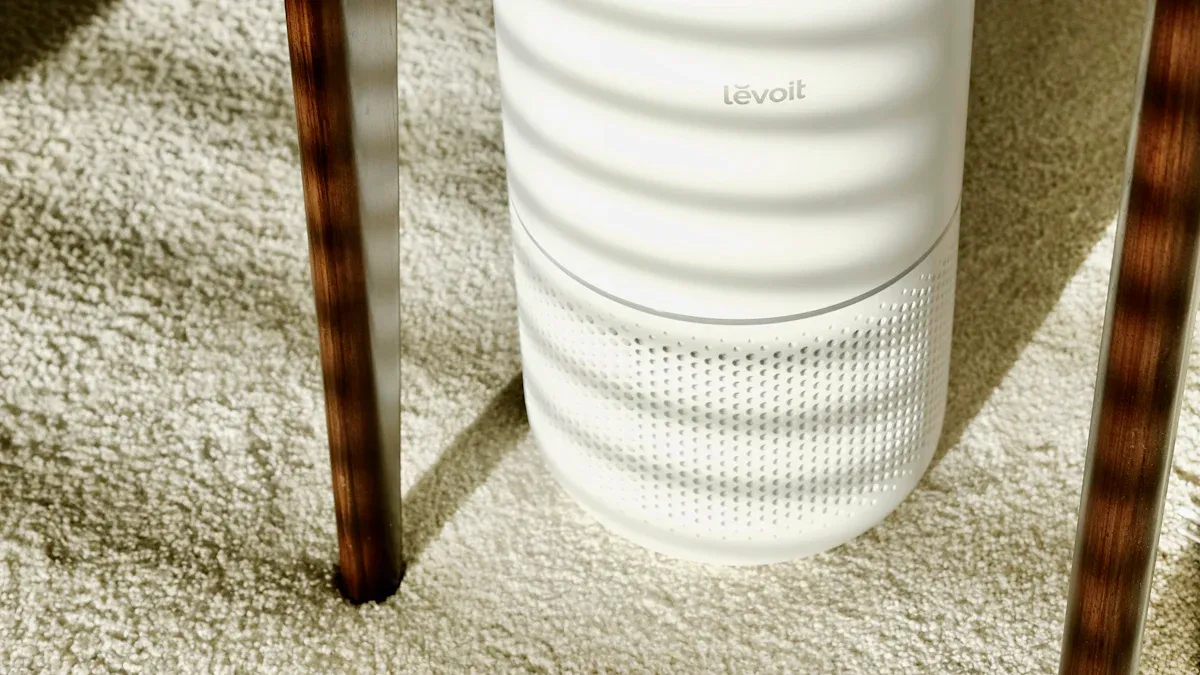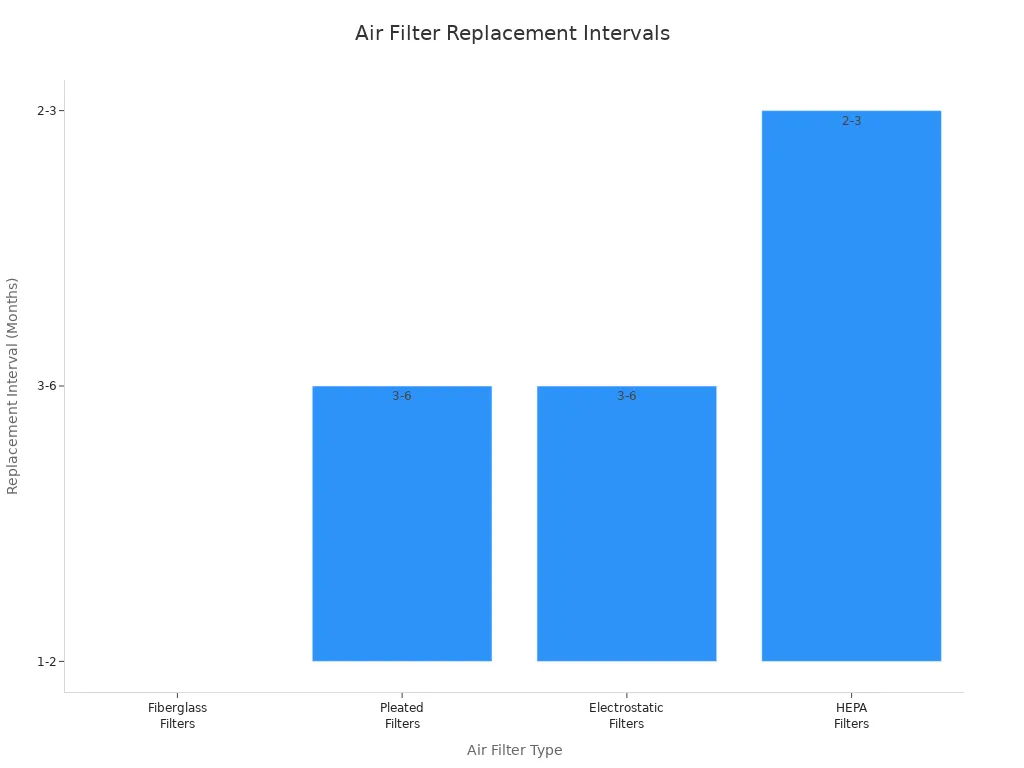
Air purifiers clean the air by taking out allergens, smells, and germs. Air filters mostly catch dust and bigger particles. Knowing the difference helps you stay healthy at home. More than 70% of homes in the U.S. use an air purifier or filter. This shows that indoor air quality is very important. Bad air can cause headaches, asthma, and trouble paying attention. Picking the right one makes your home safer and healthier.
Key Takeaways
- Air filters catch dust, pollen, and big particles in your HVAC system. This helps clean the air in your whole house.
- Air purifiers use different methods to get rid of small particles, germs, smells, and gases in certain rooms.
- HEPA filters trap 99.97% of very small particles. This helps people with allergies and asthma breathe better.
- Activated carbon and UV light in air purifiers take away smells and chemical vapors. They also kill germs that filters cannot stop.
- Using both air filters and air purifiers together gives you the best air quality. This covers dust, allergens, smells, and germs.
Air Filters
.Comparing-Air-Filters-and-Other-Dust-Removal-Methods-1024x682.webp)
What They Are
Air filters help trap unwanted things from the air in your house. You often see them in HVAC systems like furnaces or air conditioners. Most air filters use fiberglass, pleated cotton, or synthetic fibers. Some filters use static electricity to catch more stuff. HEPA filters have tightly woven fibers to trap even smaller things.
| Filter Type | Material/Construction | MERV Rating Range | Pros | Cons |
|---|---|---|---|---|
| Fiberglass | Spun glass, metal grate | ~5 | Cheapest, good for big pieces | Not very good at filtering, gets clogged fast |
| Electrostatic | Cotton and paper fibers, static charge | Variable | Catches allergens, can be reused | Not great for bigger allergens like mold spores |
| Pleated | Polyester or cotton fabric folded | 5-8 | Works better, lasts longer | Can slow airflow, costs a bit more |
| HEPA | Dense mesh for high efficiency | 11+ | Gets 99.97% of particles, great for allergies | Costs more, may slow airflow, needs right HVAC |
How They Work
Air filters clean by pushing air through a mesh or fiber. When air goes through, the filter traps dust and pollen. The MERV rating shows how well a filter works. A higher MERV rating means it catches smaller and more harmful things. The chart below shows that filters work better with higher MERV ratings:
What They Remove
Air filters can take out many common indoor pollutants. Regular filters catch dust, pollen, pet dander, and mold spores. Pleated and HEPA filters trap even smaller things like bacteria and some viruses. HEPA filters remove at least 99.97% of tiny particles as small as 0.3 microns. This helps people with allergies or asthma a lot.
Limitations
Note: Air filters do not take out everything from your air.
- Air filters cannot remove gases or smells like VOCs.
- HEPA filters might not catch all viruses because some are smaller than 0.3 microns.
- Bacteria and mold can grow in a dirty filter and get back into the air.
- Some filters, like HEPA, may not fit every HVAC system and can slow airflow if not right.
You should change your air filter often to keep your air clean and your system working well.
Air Purifiers

What They Are
Air purifiers are machines that help clean the air at home. They can take out things that make you sneeze or feel sick. Some also remove bad smells. There are different types of air purifiers. Each type uses a special way to clean the air.
- HEPA purifiers use strong filters to catch tiny things.
- Adsorbent purifiers use things like activated carbon to grab smells and gases.
- UV purifiers use special light to kill germs.
- Ionic purifiers send out ions that pull particles from the air.
- Ozone generators make ozone to break down pollutants, but you must be careful with them.
How They Work
Air purifiers pull air inside and clean it in steps. Some use filters like HEPA to catch dust and pollen. Others use activated carbon to soak up smells and gases. UV light purifiers shine a light that kills germs. Ionizers let out ions that stick to particles. This makes the particles heavy so they fall down. Many air purifiers use more than one way to clean the air.
| Technology | Primary Function | Key Strengths and Limitations |
|---|---|---|
| HEPA | Physical filtration of particles | Captures 99.97% of particles as small as 0.3 microns; great for allergens and dust; does not remove gases |
| Activated Carbon | Absorption of odors and VOCs | Removes odors and gases; does not catch fine particles |
| UV Light | Inactivation of microorganisms | Kills germs; does not remove particles; needs enough exposure time |
| Ionizers | Electrically charge particles | Helps particles settle; may create ozone, which can be harmful |
What They Remove
Air purifiers can get rid of things that air filters miss. They can help with:
- Allergens like pollen, pet dander, and dust mites
- Fine particles that can hurt your lungs
- Smells from cooking, pets, or smoke
- Gases and VOCs
- Bacteria and viruses that make you sick
Regular air filters do not catch gases, smells, or tiny germs. Air purifiers with activated carbon and UV light can clean these things. This makes your air much cleaner.
Unique Benefits
Air purifiers give you extra health benefits that air filters do not.
- Using a HEPA air purifier can help stop sneezing and itchy eyes.
- Kids with asthma may breathe better if you use an air purifier at night.
- Air purifiers lower dust and germs, which helps your lungs and heart.
- Cleaner air helps your body fight sickness.
- Studies show air purifiers can cut germs and viruses in your home by up to 99% in one hour.
If you want better air at home, air purifiers can help with both particles and germs.
Key Differences
Function
It is important to know how air filters and air purifiers work. Each one cleans your air in a different way. Air filters use mechanical or electrostatic filtration. They catch dust, pollen, and other particles as air moves through them. Most air filters are inside your HVAC system. They only work when the system is running.
Air purifiers use more than one way to clean air. They pull air in with a fan and push it through different stages. These stages can have HEPA filters, activated carbon, UV light, or ionizers. Air purifiers can trap particles, remove odors, and kill germs.
Here is a table that shows the main differences:
| Aspect | Air Filters | Air Purifiers |
|---|---|---|
| Primary Mechanism | Mechanical or electrostatic filtration that traps particles like dust and pollen | Multi-stage purification using HEPA, carbon, UV light, or ionization to trap and neutralize contaminants |
| Target Pollutants | Particulate matter such as dust, mold, bacteria, allergens | Broader range including bacteria, viruses, gases, odors, chemical vapors, and microscopic pathogens |
| Air Movement | Passive, integrated into HVAC systems, air moves through by system airflow | Active, uses fans to draw air through multiple purification stages and circulate purified air |
| Additional Technologies | Some use electrostatic filters; mainly focus on particle removal | Combine filtration with adsorption and germicidal treatments (e.g., UV light) for comprehensive cleaning |
| Maintenance | Requires regular filter replacement to maintain efficiency | May require less frequent filter changes due to additional technologies like UV light |
Tip: If you want to clean more than just dust and pollen, you should try air purifiers for extra help.
Effectiveness
You may wonder which one works better for you. Air filters are good at catching dust, pollen, and pet dander. HEPA filters can trap 99.97% of tiny particles. But air filters cannot remove odors, gases, or many germs.
Air purifiers do more. They use different technologies to remove more pollutants. Activated carbon takes away smells and gases. UV light kills bacteria and viruses. Some studies show air purifiers can remove almost all bioaerosols very fast. This makes them great for people who want cleaner air in rooms they use most.

Both air filters and air purifiers need regular care. You should change filters every 1 to 6 months, depending on the type and use. Air purifiers may also need you to clean or change HEPA and carbon filters. The machine itself can last 5 to 10 years.
Note: Air filters are best for cleaning dust and allergens in the whole house. Air purifiers are better for removing odors, gases, and germs in certain rooms.
Use Cases
Pick what you need based on your home and health. Air filters go inside your HVAC system. They clean all the air that moves through your heating and cooling. This keeps dust, pollen, and pet hair out of every room. Air filters also help protect your HVAC system from getting clogged.
Air purifiers are easy to move. You can put them in any room where you want cleaner air. They work well in bedrooms, nurseries, or living rooms. Air purifiers are best for removing smoke, cooking smells, VOCs, or germs. If you have allergies, asthma, or want to fight viruses, air purifiers give extra help.
Here are some common ways to use them:
- Use air filters for:
- Cleaning dust and pollen in the whole house
- Protecting your HVAC system
- Reducing basic allergens
- Use air purifiers for:
- Removing odors, smoke, and chemical vapors
- Lowering germs and viruses in bedrooms or offices
- Cleaning rooms with lots of pollution
Tip: Many people use both. Air filters handle dust and allergens for the whole house. Air purifiers give extra cleaning in rooms where you need it most.
Choosing the Right Solution
Allergies and Asthma
If you or your family have allergies or asthma, you want to get rid of as many triggers as you can. HEPA filters in your HVAC or in portable units can catch up to 99.97% of things like pollen, pet dander, and dust mites. Studies say using HEPA filters can lower allergens in homes by 43% to 73%. You get the best results if you run these machines for at least eight hours each day and change filters on time. Air Purifiers with special HEPA filters can help cut down on particles in the air. But you should also control other triggers, like pests and mold, for the best results.
| Solution Type | What It Removes | Best Practice |
|---|---|---|
| HEPA Air Filter | Allergens, dust, pet dander | Use in HVAC or portable units |
| Air Purifier (HEPA) | Fine particles, some microbes | Use in bedrooms, run daily |
Tip: Stay away from ozone purifiers. Ozone can make it harder to breathe.
Smoke and Odors
Smoke and smells need special care. HEPA filters catch tiny smoke pieces. Activated carbon filters soak up gases and bad smells. Air Purifiers with both HEPA and activated carbon filters work best for homes with smoke, wildfires, or strong cooking smells. The EPA says these filters are good for removing smoke and odors.
- HEPA filters grab small smoke particles.
- Activated carbon filters catch smells and chemicals.
- Multi-layer systems clean both particles and odors.
Ozone generators are not safe for cleaning indoor air.
General Dust
Dust is in every home. Air filters in your HVAC catch bigger dust and stop it from spreading. HEPA filters and Air Purifiers can lower dust in the air, making it easier to breathe. Research shows these filters work best if you also keep your home clean and let in fresh air. Filters do not work as well over time, especially in dirty or oily places. You should check and change filters often.
Using Both
Some homes need both for the cleanest air. Air filters take out big things like dust and pollen, especially where there is a lot of buildup or not much airflow. Air Purifiers go after smaller things, smells, smoke, and germs in rooms where you spend time. Using both gives you the best indoor air quality. Put air filters in your HVAC and use portable Air Purifiers in bedrooms or living rooms. This works well if you have allergies, pets, smoke, or chemicals at home.
- Use air filters for dust and allergens in the whole house.
- Use Air Purifiers for smells, smoke, and small particles in main rooms.
- Change filters often for the best results.
Note: Always pick the right device for your room size and needs. Look for Energy Star labels for better energy use.
You have learned how air filters and air purifiers are different.
- Air filters are inside HVAC systems. They catch big things like dust, pollen, and lint.
- Air purifiers go after smaller or more dangerous things. These include germs, smells, and tiny particles. They use special technology to do this.
- HVAC filters help keep your home comfortable. Air purifiers work to get rid of bad stuff in the air.
Think about what you need for clean air. Check your room size and the kind of filter. If you want the best air, use both at the same time.
FAQ
What is the main difference between an air filter and an air purifier?
You use an air filter to trap dust and large particles. You use an air purifier to remove smaller particles, odors, and germs. Air purifiers often use more than one technology to clean your air.
What should you look for when choosing an air purifier?
You should check the Clean Air Delivery Rate (CADR), filter type, and room size. Look for HEPA and activated carbon filters for best results. Make sure the purifier fits your space.
What can air filters not remove from your home air?
Air filters cannot remove gases, odors, or many germs.
You need an air purifier with activated carbon or UV light to target these pollutants.
What is the best way to use both an air filter and an air purifier?
You can use an air filter in your HVAC system for whole-house dust control. Place air purifiers in rooms where you want extra cleaning. This gives you the best air quality.
What maintenance do air purifiers and air filters need?
You should change air filters every 1 to 3 months. Clean or replace air purifier filters as the maker suggests. Regular care keeps your air clean and your devices working well.
See also
How Humidifiers Impact Dust and Cleanliness in Your Space
Do Air Purifiers Make a Difference for Dust Allergies
Simple Methods for Monitoring Air Quality with AQI Sensors
Things to Consider Before Buying an AQI Sensor Air Purifier with Display
